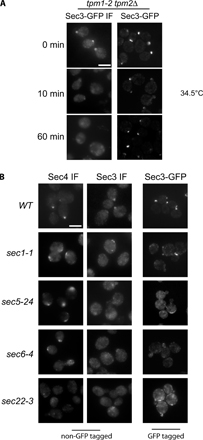
[View Larger Version of this Image]
Figure S1. Detection of Sec3 localization in yeast cells by immunofluorescence and GFP tagging. (A) Sec3 in the tpm1-2 tpm2∆ mutant was GFP tagged by chromosomal integration so that the sole copy of Sec3 in the cells was expressed as Sec3-GFP. Sec3 in the cells was then detected either by immunofluorescence using the anti-GFP antibody or directly by monitoring GFP fluorescence. At 25°C, both methods detected Sec3-GFP at the bud tip. However, after a shift to 37°C for 60 min, Sec3-GFP detected by direct GFP fluorescence was well polarized, whereas Sec3-GFP detected by immunofluorescence using anti-GFP antibody was partially diffused. The difference in localization pattern reflects the difference in the method of cell treatments for immunofluorescence and direct GFP fluorescence observation (Materials and methods). (B) Wild-type (WT) mutants defective in post-Golgi secretion (sec1-1, sec5-24, and sec6-4) and a mutant defective in ER-to-Golgi transport (sec22-3) were shifted from 25 to 37°C for 1 h. The localization of endogenous Sec3 and Sec4 in these cells was examined by immunofluorescence microscopy (Sec3 Sec4 IF). In a parallel set, Sec3 in these strains was tagged with GFP by chromosomal integration and Sec3-GFP was monitored by fluorescence microscopy. Sec4 was polarized in wild-type, sec1-1, sec5-24, and sec6-4 cells but not in sec22-3 cells (left). Sec3 was mislocalized in all these mutants as detected by immunostaining (middle). Consistent with the immunofluorescence result, Sec3-GFP was also mislocalized in these mutant cells (right). Bars, 5 μm. The results of Sec3 mislocalization in sec mutants are consistent with those reported by Roumanie et al. (2005. J. Cell Biol. 170:583–594), which suggest that stable polarization of Sec3 at the bud tip needs the proper function of membrane trafficking in the cell. Based on the above data, we believe that the localization of Sec3-GFP indeed reflects the localization of endogenous Sec3 in yeast cells. Consistent with the above comparative imaging studies, we have also found yeast cells expressing Sec3-GFP under the SEC3 promoter as the only form of Sec3 to grow as well as the parental untagged strain under all the conditions tested (not depicted).